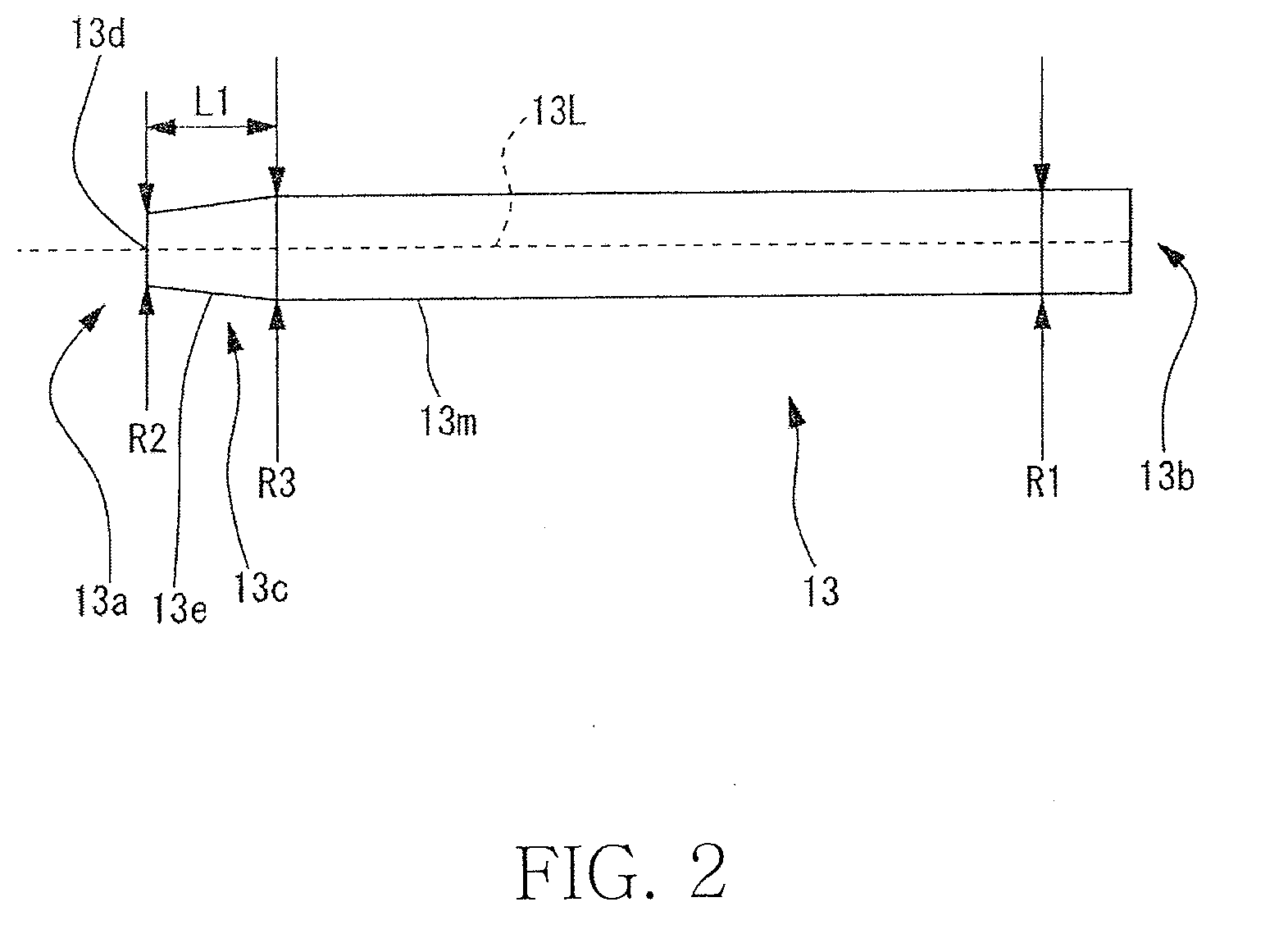Vitreous silica crucible manufacturing apparatus
- Summary
- Abstract
- Description
- Claims
- Application Information
AI Technical Summary
Benefits of technology
Problems solved by technology
Method used
Image
Examples
example 1
[0072]Using the vitreous silica crucible manufacturing apparatus of the present invention, arc discharge was performed under different conditions of R2 shown in Table 1 so as to manufacture the vitreous silica crucible, and generation of vibration and attachment of fume to the electrode were visually determined and compared. The result is shown in Table 1. Here, in the judgment, a stable degree of arc which is most desirable for manufacture of the vitreous silica crucible was denoted by “⊚”, a desirable degree was denoted by “O”, an undesirable degree was denoted by “x”.
[0073]Crucible diameter: 32 inches
[0074]Output: 3,000 kVA
[0075]Treatment time: 30 minutes
[0076]Electrode shape: front end truncated cone
[0077]θ1 / 2: 10°
[0078]θ2: 4°
[0079]Carbon electrode diameter R1: 50 mm
[0080]Power density P / P2 of carbon electrode: 153 to 611 kVA / cm2
TABLE 1*Exp.Exp.Exp.Exp.Exp.Exp.Exp.ExampleExampleExampleExampleExampleExampleExample1234567θ½ [°]10L1 [mm]120R1 [mm]50R2 [mm]40353043502825R2 / R10.800.7...
example 2
[0082]Arc discharge was performed under the same condition as Example 1 except that R2 is set to a predetermined value of 30 mm and L1 is changed so as to manufacture the vitreous silica crucible, and generation of vibration and attachment of fume to the electrode were visually determined and compared. The result is shown in Table 2.
TABLE 2*Exp.Exp.Exp.Exp.Exp.Exp.Exp.ExampleExampleExampleExampleExampleExampleExample891011121314θ½ [°]10R1 = R3 [mm]50R2 [mm]30L1 [mm]2001501201055530100L1 − x / tan1459565500−25+45(θ½) [mm]VibrationAbsenceAbsenceAbsenceSlightlyPresencePresencePresencepresenceAttachmentAbsenceAbsenceAbsenceAbsenceAbsenceAbsenceAbsenceof fumeJudgment⊚⊚⊚◯XXX*Exp. = Experimental
[0083]From the above result, it can be seen that stable arc can be obtained if L1−X / tan(θ1 / 2) is 50 mm or When L1−X / tan(θ1 / 2) is too large, an undesirable result is obtained in view of cost for manufacturing the electrode. Thus, L1−X / tan(θ1 / 2)<150 mm is preferable.
example 3
[0084]Arc discharge was performed under the same condition as Example 1 except that R2 is set to a predetermined value of 30 mm and R3 is changed so as to manufacture the vitreous silica crucible, and generation of vibration and attachment of fume to the electrode were visually determined and compared. The result is shown in Table 3.
TABLE 3*Exp.*Exp.*Exp.*Exp.*Exp.*Exp.ExampleExampleExampleExampleExampleExample151617181920θ½ [°]10L1 [mm]120R1 [mm]50R2 [mm]30R3 [mm]504543403835R3 / R1 [—]1.000.900.860.800.760.70VibrationWeakAbsenceAbsenceSlightlyPresencePresencepresenceAttachmentAbsenceAbsenceAbsenceAbsenceAbsenceAbsenceof fumeJudgment⊚⊚⊚◯XX*Exp. = Experimental
[0085]From the above result, it can be seen that, in R3 / R1<0.8, arc becomes unstable because vibration is generated.
PUM
| Property | Measurement | Unit |
|---|---|---|
| Angle | aaaaa | aaaaa |
| Angle | aaaaa | aaaaa |
| Length | aaaaa | aaaaa |
Abstract
Description
Claims
Application Information
 Login to View More
Login to View More - R&D
- Intellectual Property
- Life Sciences
- Materials
- Tech Scout
- Unparalleled Data Quality
- Higher Quality Content
- 60% Fewer Hallucinations
Browse by: Latest US Patents, China's latest patents, Technical Efficacy Thesaurus, Application Domain, Technology Topic, Popular Technical Reports.
© 2025 PatSnap. All rights reserved.Legal|Privacy policy|Modern Slavery Act Transparency Statement|Sitemap|About US| Contact US: help@patsnap.com



